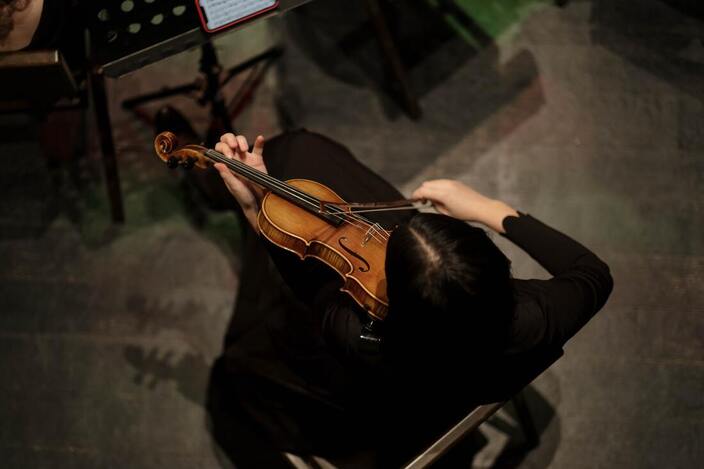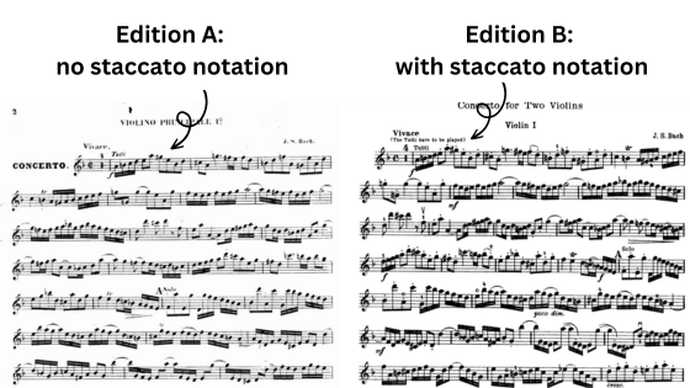Violin Bow Techniques: Staccato, Spiccato, Sautillé, and Others
© Goh Tong Keat
|
|
How to Interpret Staccato
Staccato is a musical term for notes that are played short and detached. Notes to be played with Staccato are simply notated with a dot above or below. Staccato can also be used as a term to describe the overall articulation of a passage or a piece. The opposite of Staccato is Legato, which means smooth.
Staccato itself is not exactly a type of bowing technique. When violinists see Staccato in printed music, we need to determine what technique to employ on these notes. The decision we make must reflect the style of the music and the composers’ intentions. Technically, when there is a note marked with Staccato, we can make it shorter by playing only half of the note value. However, this does not fully describe the articulation.
In most classical repertoire, a running passage of Staccato notes often means some sort of bouncing bow-strokes (e.g., Spiccato or Sautillé). Staccato is sometimes marked on notes to be played with Martelé as well. If it involves dotted rhythm, it may also be suggesting Hooked Bow. Things get more complicated when there are slurs involved. When two or more Staccato notes are slurred, we have to decide if it is a Slurred Staccato, Flying Spiccato, Ricochet, or something else.
In Baroque music (and some Classical-period music), certain notes in the fast (and sometimes slow) movements are to be played detached even when they are not marked with Staccato. However, some editors would add to the score Staccato markings that were not there in the original manuscripts. Usually when playing these detached notes in Baroque music, the bow hair does not leave the string entirely but rather "lightening" towards the end of the bow-stroke.
Staccato itself is not exactly a type of bowing technique. When violinists see Staccato in printed music, we need to determine what technique to employ on these notes. The decision we make must reflect the style of the music and the composers’ intentions. Technically, when there is a note marked with Staccato, we can make it shorter by playing only half of the note value. However, this does not fully describe the articulation.
In most classical repertoire, a running passage of Staccato notes often means some sort of bouncing bow-strokes (e.g., Spiccato or Sautillé). Staccato is sometimes marked on notes to be played with Martelé as well. If it involves dotted rhythm, it may also be suggesting Hooked Bow. Things get more complicated when there are slurs involved. When two or more Staccato notes are slurred, we have to decide if it is a Slurred Staccato, Flying Spiccato, Ricochet, or something else.
In Baroque music (and some Classical-period music), certain notes in the fast (and sometimes slow) movements are to be played detached even when they are not marked with Staccato. However, some editors would add to the score Staccato markings that were not there in the original manuscripts. Usually when playing these detached notes in Baroque music, the bow hair does not leave the string entirely but rather "lightening" towards the end of the bow-stroke.
Spiccato
Spiccato is a bowing technique where the bow is bouncing on the string. To play Spiccato, a player will drop the bow onto the string and let it rebound until the bow hair leave the string. After the rebound, the player may continue with another Spiccato in the opposite direction by dropping the bow again.
To be able to perform a good Spiccato, there are a few things to consider. For Spiccato at a slower pace, we allow the bow to rebound higher, and in a faster passage, we reduce the height of the bounce to keep up with the tempo. A steep angle where the bow drops almost vertically would produce a short and spiky note, whereas if we flatten the angle, we can get a rounder sound. The movements of the bow when playing repeated Spiccato notes would look like the letter "V" for a very spiky sound, or letter "U" (or the shape of a saucer) for a more gentle and rounded sound.
The part of the bow used for Spiccato also varies according to the sound we want. Playing closer to the frog can produce a heavier and louder sound; while playing closer to the middle produces a lighter and softer tone.
To be able to perform a good Spiccato, there are a few things to consider. For Spiccato at a slower pace, we allow the bow to rebound higher, and in a faster passage, we reduce the height of the bounce to keep up with the tempo. A steep angle where the bow drops almost vertically would produce a short and spiky note, whereas if we flatten the angle, we can get a rounder sound. The movements of the bow when playing repeated Spiccato notes would look like the letter "V" for a very spiky sound, or letter "U" (or the shape of a saucer) for a more gentle and rounded sound.
The part of the bow used for Spiccato also varies according to the sound we want. Playing closer to the frog can produce a heavier and louder sound; while playing closer to the middle produces a lighter and softer tone.
Sautillé
As Spiccato requires the bow hair to leave the string entirely as it bounces, it is usually used in slow or medium tempo. On the other hand, Sautillé (or Saltando) is used for fast passage. Sautillé is played in the middle of the bow with rapid successions of short bow strokes.
It is best to play it with relaxed hand and fingers, along with some minor movements in the forearm. Because of the speed of the bow strokes, the bow stick would be bouncing while the bow hair stays on the string. An example of Sautillé bowing can be found in Carl Bohm’s Perpetuo Mobile.
It is best to play it with relaxed hand and fingers, along with some minor movements in the forearm. Because of the speed of the bow strokes, the bow stick would be bouncing while the bow hair stays on the string. An example of Sautillé bowing can be found in Carl Bohm’s Perpetuo Mobile.
Other Types of Off-String Bow
A Slurred Staccato of two or more notes means playing the notes in the same bowing direction, but with space in between each note. These notes can be played firmly on the string or allowed to come off the string with a little Collé (see below) action. Galamian differentiated these two as “Solid Staccato” and “Flying Staccato” in his Principles of Violin Playing and Teaching.
In Collé, which means "glued" in French, the bow is first pressed onto the string and then lifted off the string with a quick action from the fingers, producing a "click" at the start of a note. The bow has to be first placed in contact with the string and therefore it is different from Spiccato where the bow drops onto the string and bounce.
Flying Spiccato implies a series of Spiccato notes played in the same bowing direction, commonly on the up-bow. A good example of Flying Spiccato is found in Paganini’s Caprice No.10.
Ricochet, on the other hand, is usually played on the down-bow. It requires slapping or throwing the bow in the upper middle part, onto the strings and setting off a series of natural bounces. The Ricochet usually ends with a note in the opposite direction.
In Collé, which means "glued" in French, the bow is first pressed onto the string and then lifted off the string with a quick action from the fingers, producing a "click" at the start of a note. The bow has to be first placed in contact with the string and therefore it is different from Spiccato where the bow drops onto the string and bounce.
Flying Spiccato implies a series of Spiccato notes played in the same bowing direction, commonly on the up-bow. A good example of Flying Spiccato is found in Paganini’s Caprice No.10.
Ricochet, on the other hand, is usually played on the down-bow. It requires slapping or throwing the bow in the upper middle part, onto the strings and setting off a series of natural bounces. The Ricochet usually ends with a note in the opposite direction.
|
|
|
Related Bow-Strokes
As mentioned earlier, notes to be played Martelé may be marked with Staccato as well. A Martelé bow-stroke starts with a "bite" and followed by a quick release, creating an accented note. Violinists typically choose to play with this bow stroke by the context of the music, and not solely by the notation on printed music.
Hooked Bow refers to pair of notes marked with a slur and an articulation (staccato/tenuto/accent) on the second note, commonly seen in pairs of "long-short" notes in dotted rhythm or compound time. In this case, the second note is being "re-articulated" instead being played smoothly within a slur. Again, violinist should interpret it based on the context of music as notations alone are oftentimes inconsistent.
Portato bow is used on a series of two or more notes under a slur, with each note marked with a tenuto sign. Each note is then gently executed in the same bowing direction, but with some space in between. It is different from slurred staccato where each note is more accentuated.
Hooked Bow refers to pair of notes marked with a slur and an articulation (staccato/tenuto/accent) on the second note, commonly seen in pairs of "long-short" notes in dotted rhythm or compound time. In this case, the second note is being "re-articulated" instead being played smoothly within a slur. Again, violinist should interpret it based on the context of music as notations alone are oftentimes inconsistent.
Portato bow is used on a series of two or more notes under a slur, with each note marked with a tenuto sign. Each note is then gently executed in the same bowing direction, but with some space in between. It is different from slurred staccato where each note is more accentuated.


